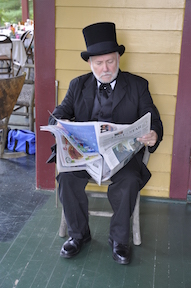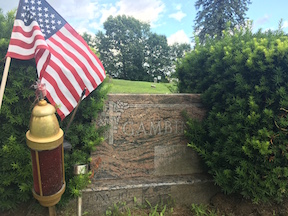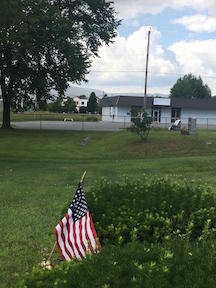Grant’s Last Battle Redux
 I’m always excited to have a box of my books show up on my doorstep from the printer. This week, it was the newly printed second edition of Grant’s Last Battle. As a parent, you’re not supposed to have a favorite child; as an author, the same is supposed to be true about your books, I guess. But if I had a favorite, I would be Grant’s Last Battle.
I’m always excited to have a box of my books show up on my doorstep from the printer. This week, it was the newly printed second edition of Grant’s Last Battle. As a parent, you’re not supposed to have a favorite child; as an author, the same is supposed to be true about your books, I guess. But if I had a favorite, I would be Grant’s Last Battle.
I like to tell people I wrote a book about a guy writing a book—which, I admit, sounds incredibly nerdy. To the writer in me, though, the whole idea of it is delicious. And of course, I know that the premise is far more than that. The guy writing the book is the man who won the Civil War. And he’s recovering from complete financial collapse, writing to stave off destitution. And he’s dying of throat cancer. Painfully. He’s up against the ultimate deadline.
I took great effort to work as much detail as I could into the book to make the story as rich and full as possible (especially considering the “overview” style of Emerging Civil War Series books). Including more than 220 photos certainly helped! The wonderful folks at Grant Cottage were especially gracious in offering their help as I pulled everything together.
But of course, no matter how hard one works, and how many proofreading eyes pour over a manuscript, gremlins always slip in. And, inevitably, they are the first things to jump out at me and slap me across the face as soon as I open a book—errr. Fortunately, we’ve had the opportunity to improve the ECWS’s proofreading process since this book came out, so typos are less of an aggravation than they once were. One of the things I’m grateful for with this new edition, however, is that I had the chance to correct some of those missed copyedits.

I also called in a couple ringers to look over the book for me one more time before going to press. Steve Trimm and William Underhill both volunteer at Grant Cottage. Steve, who has a background in community theater, employs his formidable skills during the year to put on a number of living history programs. He often portrays Grant, but just as often, he assumes the role of one of the many other colorful characters who’ve played a part in the history of Grant Cottage. His first-person programs bring those stories to life for visitors as part of the Cottage’s annual “porch talk” series.
Like Steve, Bill as a member of the Friends Grant Cottage (and you should consider being one, too!). Bill has amassed one of the most impressive digital collections of Grant-related material anywhere in the world. Every day, he sends an email to a legion of Grant admirers and Friends, sharing something from his treasure trove. He’s also searching the internet daily for new things about Grant he can share. His collection has become a true Grant treasure, and his daily emails are a treat.

Steve and Bill, who’ve both been extremely supportive of the book, agreed to give it a close read before we went to a second edition. They each made a couple suggestions that let me correct or clarify a couple small things, which is extremely important to me. Telling this story has always been a privilege for me, and so I want to do my best to be sure I share it as accurately as possible.
The addition I was most glad about actually relates to the post-Grant part of Grant Cottage’s story. One of the caretakers of the Cottage was a Japanese immigrant, Suye Narita, who came to American in 1914 when she was 13 years old. She arrived on Mt. McGregor, where Grant Cottage is located, for treatment at a sanitarium that once topped the mountain. The caretakers of the Cottage at the time, Oliver and Josie Clarke, adopted Suye, and when they eventually passed away, Suye took over the caretaking responsibilities. (Their story is told in wonderful detail by Steve Trimm in his book Saving Grant Cottage: How a Survivor of Andersonville, A Housewife, A Medical Missionary, An Immigrant from Japan (and Others) Saved a Precious Piece of Our History, a history of Grant Cottage that I highly recommend.)
When Suye died in 1984, she wanted to be buried within sight of Grant Cottage. Unfortunately, by that time, a state prison occupied most of the mountaintop, so she wasn’t allowed to be buried up there. Instead, she was buried at a cemetery near the foot of the mountain.
 I had tried on two separate occasions to find Suye’s grave—to no avail. Finally, during a visit this past spring, I found her grave thanks to the assistance of Grant Cottage’s groovy site manager, Dave Hubbard. Suye rests in Ellsworth Cemetery along Ballard Road (not the much older cemetery across the street, as I found out the hard way!). She rests there in a plot beside her husband, Tony “Joe” Gambino, with Mt. McGregor overlooking them in the distance. I grabbed a couple photos of their shrub-flanked headstone for inclusion in the book, where I was able to expand on Suye’s story a little. To me, those little gems add a lot to a book’s overall texture—and I think it’s a nice way to honor the work of people who do so much to steward our history, to boot.
I had tried on two separate occasions to find Suye’s grave—to no avail. Finally, during a visit this past spring, I found her grave thanks to the assistance of Grant Cottage’s groovy site manager, Dave Hubbard. Suye rests in Ellsworth Cemetery along Ballard Road (not the much older cemetery across the street, as I found out the hard way!). She rests there in a plot beside her husband, Tony “Joe” Gambino, with Mt. McGregor overlooking them in the distance. I grabbed a couple photos of their shrub-flanked headstone for inclusion in the book, where I was able to expand on Suye’s story a little. To me, those little gems add a lot to a book’s overall texture—and I think it’s a nice way to honor the work of people who do so much to steward our history, to boot.
If you’ve not picked up Grant’s Last Battle, I hope you take the opportunity to do so. It’s a remarkable story. If you have read it already, thank you for picking up the book! If you get the new edition, you’ll find a few new tidbits sprinkled here and there that might be of interest. Mostly, for me as a writer, it’s a chance to hone my craft even sharper so that I do justice to a story that has done so much for me.

You have alot of great books Mr. Chris, 2nd Fredricksburg, Perryville, and many more-in fact i’m not ashamed to say I really look up to you and what you’ve accomplished. Keep up the great work!!!